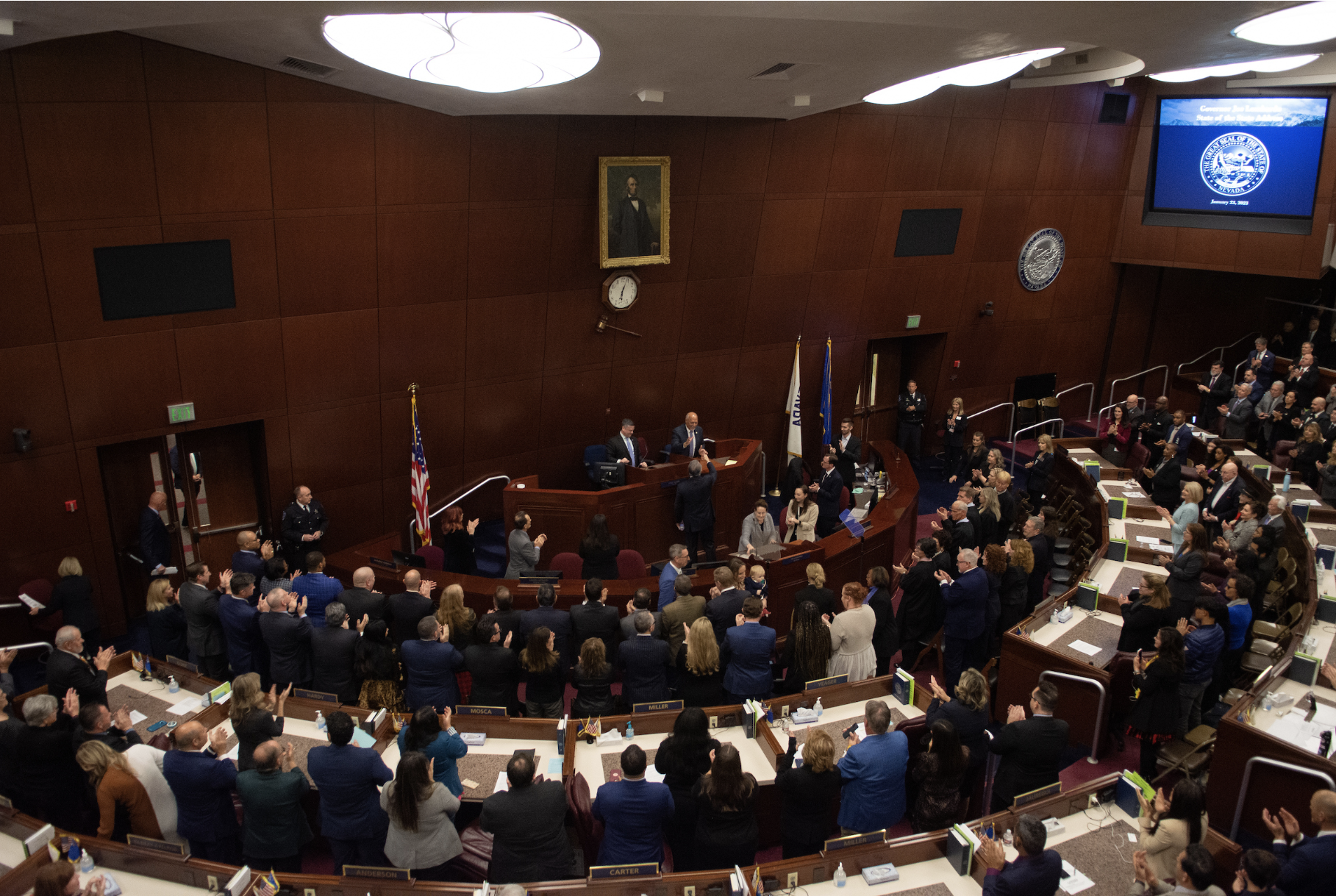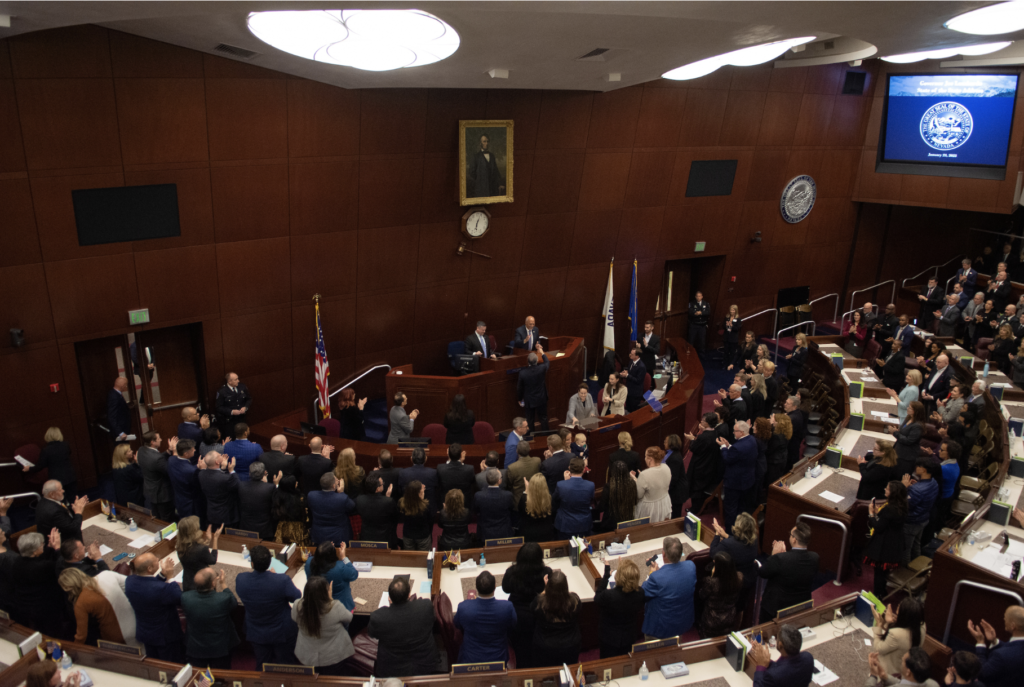Published in the High Desert Advocate Newspaper, May 12th, 2023 Edition.
Governor Joe Lombardo during his first State of the State inside the Assembly Chamber at the Legislature on Jan. 23, 2023. (David Calvert/The Nevada Independent) (photo credit David Calvert/The Nevada Independent)
By Sean Golonka (The Nevada Independent)
Nevada lawmakers will have $251 million more than previously projected to build into the state budget, as economic forecasters predict a milder economic slowdown and sustained growth in revenue from sales and gaming taxes.
The revised forecast approved by the Economic Forum on Monday is a slight improvement over December’s revenue forecast, and enlarges a pot that will fund the largest budget in state history. The projections include $201 million more than previously projected for the upcoming two-year budget, and an extra $50 million in surplus revenue for the current fiscal year ending in June.
In a statement, Gov. Joe Lombardo’s chief of staff, Ben Kieckhefer, said the governor’s office would submit budget amendments reflecting the enhanced tax revenue, but said the office would seek to avoid “overspending.”
“Significant portions of the new revenue forecasted today are one-time funds, and our office believes that they should be treated as such,” Kieckhefer said in a statement.
The state’s two primary revenue sources — sales and gaming tax collections — have boomed amid a period of high inflation and the state’s emergence from the COVID-19 pandemic, which hampered the gaming industry. The growth in tax collections has driven up the state’s cash on hand and resulted in its highest ever projected revenues to the general fund (the primary account for state tax revenues, which is used to fund a variety of services from education to public health).
In December, the Economic Forum — a five-member panel of private sector business experts appointed by the governor that is responsible for forecasting tax revenues that determine the size of the state’s two-year budget — projected the state would bring in $11.4 billion in general fund revenue after the application of tax credits ($11.6 billion before tax credits) over the two-year budget period stretching from July 1, 2023, to June 30, 2025.
That number was used by state budget officials to craft Lombardo’s proposed executive budget, but now he and legislators have more than $11.6 billion after tax credits to appropriate over the biennium. General fund revenues projected for the biennium total more than $11.8 billion before tax credits — a significant, 26 percent increase over the current two-year budget period, approved during the last legislative session in May 2021 at more than $9.2 billion.
In a statement, Lombardo’s office said it would submit budget amendments including:
$25 million in one-time appropriations for furniture, fixtures and equipment for state offices
$6 million in funding for SB431, a Lombardo-backed bill aimed at modernizing state government
$3.3 million to fund the proposed Office of School Choice, which would be created under Lombardo’s AB400
Additional funding for charter school transportation and “critical social services infrastructure”
Assembly Speaker Steve Yeager (D-Las Vegas) said in a statement the “additional revenue should be used to boost funding for critical public services,” including education, affordable housing, mental health and public safety. Senate Majority Leader Nicole Cannizzaro (D-Las Vegas) said in a statement the updated projections show Nevada is “in a strong position to address many long-time unmet needs,” and similarly called for investments in education, health care and housing.
Legislative fiscal analyst Michael Nakamoto said several of the increased projections from the December to May forecasts — particularly those tied to the gaming industry — were driven by larger-than-expected revenue collections in the current fiscal year, but other revenue forecasts did not change significantly from December as the economy has not seen major changes in the past six months.
For multiple revenue streams, including the largest one for the state, the sales and use tax, forum members opted to maintain the projections they approved at their December meeting — meaning fewer changes to the size of the budget.
On top of the extra $201 million to cover potential appropriations in the next two years not previously accounted for in the governor’s recommended budget, the state will enter the upcoming fiscal year with about $2 billion in surplus.
As collections from sales and gaming taxes have soared because of high spending and rising prices, the state collected about $1 billion more in the first year of the budget period than projected in May 2021 and, with the latest projections approved Monday by the forum, is set to collect about $1 billion more in the current fiscal year than projected and legislatively accounted for in 2021.
The forum approved the updated revenue projections after deciding between predictions submitted by state fiscal analysts, various state agencies, the governor’s budget office and Moody’s Analytics. The forum meets in December of even-numbered years and May of odd-numbered years to review forecasts of the state’s seven major tax sources: sales and use tax, percentage fees tax on gaming revenues, insurance premium tax, Modified Business Tax, Commerce Tax, Live Entertainment Tax and Real Property Transfer Tax.
Under state law, the budget must be based on the projection approved in May, and lawmakers are constitutionally required to balance the state budget — spending no more than projected incoming tax revenue.
Read further below to explore highlights of projections for the state’s major revenue sources.
Budget tensions
The extra funds give lawmakers greater flexibility to tackle a variety of areas that state leaders have long described as underfunded, including pay for state workers and local educators. But alongside Lombardo, Republican lawmakers have cautioned fiscal responsibility in ramping up spending, pointing to past economic downturns, including the pandemic and the Great Recession, that saw furloughs and sweeping cuts to state spending.
The two sides have butted heads over Lombardo’s proposal to inject more into state savings by raising a cap on the size of the Rainy Day Fund — a savings account used to support state government during financial emergencies — from 20 percent of general fund appropriations in a year to 30 percent. Under the projections approved Monday by the forum, that would mean raising the cap in the upcoming fiscal year from more than $1.1 billion to around $1.7 billion.
Yeager has instead called for investing more in government, such as youth mental health services and education.
Republicans and Democrats have also offered differing visions for boosting state worker pay, which has lagged behind the inflation rate for decades. On top of Lombardo’s proposed raises for state employees of either 8 percent or 10 percent in the upcoming year and 4 percent in the following year, Democratic lawmakers are backing proposals to provide an extra 2 percent raise before the end of June and trim employees’ share of contributions to the Public Employees’ Retirement System.
But Senate Republicans voted against a bill that would have provided the 2 percent raises, as well as arbitration awards owed to a pair of state worker unions. Senate Minority Leader Heidi Seevers Gansert (R-Reno) argued the state should not award pay raises that it cannot sustain long term.
Revenue projections:
Sales and use tax
Members of the forum projected that the state would collect more than $3.76 billion over the next two fiscal years from the state’s 2 percent share of the sales and use tax. Other portions of the sales tax, which ranges from nearly 7 percent in several rural counties to more than 8 percent in urban Clark and Washoe counties, is allocated to local governments, schools and more.
With no state income tax, Nevada is reliant on sales taxes to make up the largest portion of its tax base, about 30 percent of general fund revenues.
The amount approved Monday for the upcoming two-year budget cycle was unchanged from the forum’s December forecast, as members of the panel decided to settle on a middle ground between projections presented by the Department of Taxation and multiple financial analysts.
Still, the projection marks a 12 percent increase over projected revenue from the tax as compared with the last two-year budget approved in 2021.
Tax collections have surged since the economic downturn early in the pandemic, with inflation reaching a 40-year high last year and driving up prices and spending. In December, the state set a record with more than $8.2 billion recorded in taxable sales statewide — an amount that resulted in $168 million deposited into the general fund.
Emily Mandel, an economist with Moody’s Analytics, highlighted the possibility for spending to remain high even in the face of high inflation. She noted that most households still have extra cash on hand as rising wages and federal stimulus payments awarded during the pandemic have increased income for higher wage earners.
But if inflation does not come down, spending may slow, especially for lower-income households that may already be restricted by high inflation.
Mandel also pointed to some cracks in the economy, including the recent banking crisis, that could slow consumer spending, and she said the increases in federal interest rates could further restrict financial lending.
Gaming percentage fees tax
Nevada’s gaming industry has boomed in the aftermath of pandemic shutdowns, recording more than $1 billion in statewide revenue for the 25th consecutive month in March. Though economists and members of the forum expect growth in revenue to slow, they do not anticipate any dip in amounts collected.
The forum approved a forecast of $1.9 billion in collections from the gaming percentage fee tax during the next two fiscal years — an increase of nearly $79 million over projections originally set in December.
The approved amount was higher than forecasts from the Gaming Control Board, which projected lower amounts of revenue in the 2024 and 2025 fiscal years than other analysts. Michael Lawton, an analyst with the board, said the agency expects revenue to peak in the current fiscal year ending in June.
He noted that the most recent month with data, March 2023, saw a decline in revenue from March 2022, during which the industry recorded its second highest revenue for a single month ever.







